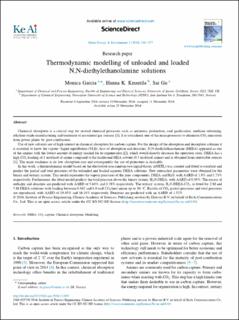| dc.contributor.author | Garcia, Monica | |
| dc.contributor.author | Knuutila, Hanna K | |
| dc.contributor.author | Gu, Sai | |
| dc.date.accessioned | 2020-04-28T14:06:33Z | |
| dc.date.available | 2020-04-28T14:06:33Z | |
| dc.date.created | 2016-11-29T13:29:05Z | |
| dc.date.issued | 2016 | |
| dc.identifier.citation | Green Energy & Environment. 2016, 1 (3), 246-257 . | en_US |
| dc.identifier.issn | 2468-0257 | |
| dc.identifier.uri | https://hdl.handle.net/11250/2652811 | |
| dc.description.abstract | Chemical absorption is a crucial step for several chemical processes such as ammonia production, coal gasification, methane reforming, ethylene oxide manufacturing and treatment of associated gas streams [1]. It is considered one of the main processes to eliminate CO2 emissions from power plants by post-combustion.
Use of new solvents are of high interest in chemical absorption for carbon capture. For the design of the absorption and desorption columns it is essential to know the vapour–liquid equilibrium (VLE), heat of absorption and densities. N,N-diethylethanolamine (DEEA) appeared as one of the amines with the lowest amount of energy needed for its regeneration [2], which would directly decrease the operation costs. DEEA has a high CO2 loading of 1 mol/mol of amine compared to the traditional MEA solvent (0.5 mol/mol amine) and is obtained from renewable sources [1]. The main weakness is its low absorption rate and consequently the use of promoters is desirable.
In this work, a thermodynamic model based on the electrolyte non-random two-liquid theory (eNRTL) was created and fitted to correlate and predict the partial and total pressures of the unloaded and loaded aqueous DEEA solutions. New interaction parameters were obtained for the binary and tertiary system. This model represents the vapour pressures of the pure components, DEEA and H2O, with AARD of 1.9% and 1.73% respectively. Furthermore, the fitted model predicts the total pressure above the binary system, H2O-DEEA, with AARD of 0.05%. The excess of enthalpy and densities are predicted with AARD of 5.63% and 1.38% respectively. The tertiary system, H2O-DEEA-CO2, is fitted for 2 M and 5 M DEEA solutions with loading between 0.042 and 0.9 mol CO2/mol amine up to 80 °C. Results of CO2 partial pressures and total pressures are reproduced, with AARD of 19.45% and 16.18% respectively. Densities are predicted with an AARD of 1.52%. | en_US |
| dc.language.iso | eng | en_US |
| dc.publisher | Elsevier | en_US |
| dc.rights | Attribution-NonCommercial-NoDerivatives 4.0 Internasjonal | * |
| dc.rights.uri | http://creativecommons.org/licenses/by-nc-nd/4.0/deed.no | * |
| dc.title | Thermodynamic modelling of unloaded and loaded N,N-diethylethanolamine solutions | en_US |
| dc.type | Peer reviewed | en_US |
| dc.type | Journal article | en_US |
| dc.description.version | publishedVersion | en_US |
| dc.source.pagenumber | 246-257 | en_US |
| dc.source.volume | 1 | en_US |
| dc.source.journal | Green Energy & Environment | en_US |
| dc.source.issue | 3 | en_US |
| dc.identifier.doi | 10.1016/j.gee.2016.11.003 | |
| dc.identifier.cristin | 1405734 | |
| dc.description.localcode | Open Access CC-BY-NC-ND | en_US |
| cristin.ispublished | true | |
| cristin.fulltext | original | |
| cristin.qualitycode | 1 | |

